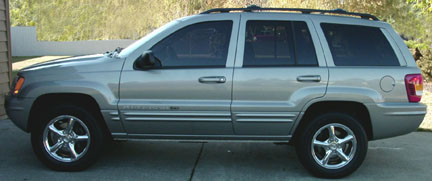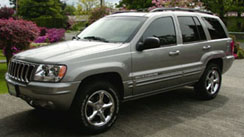 |
 |
 |
| Shown above, a 2002 Grand Cherokee with Llumartm brand film installed on driver and passenger side windows. The film darkness is rated at 15% and the shade color is Dark Charcoal. Darkness ratings may vary among different companies, the 15% Llumar may be comparable to other brands' 20% ratings. The Llumar 15% is almost an undetectable match to the factory tint. Most states prohibit levels below 35%, and some have other restrictions as well. It is best to check with the laws in your state before having your windows tinted. You'll find a nicely detailed State Law Chart at WindowTinting.com |
|
Besides cosmetics and privacy, there are several other advantages of tinting - to reject heat and reduce glare (reducing the demand on your car's air conditioner), to cut damaging ultraviolet rays (by up to 99%, helping to protect your car's interior), and making the glass more shatter resistant.
All window tinting has a life span. Cheaper economy versions may only last 2 to 4 years while premium film lasts twice that long or more depending on quality of installation and the climate. One of the top rated and more popular brands is Llumartm. Window tinting is best done by professionals, shop around for companies that specialize in luxury vehicles and have a reputation of quality work.
You should treat your window tinting with the utmost care. It can be easily scratched or marred. Clean your inside window film with a damp soft cloth, using mild soap and water. Use of harsh cleaners such as Windextm or other ammonia based cleaners WILL shorten the life span of the film. Professional silicone polish/cleaners made specifically for use on window film is also acceptable. |
 |
| A 2001 Grand Cherokee LTD with 35% tint installed. The 35% tint is slightly lighter than the factory tint but it's difficult to tell the difference. |
|
|
| Two more shots of the 2002 Limited with aftermarket tint installed. |
|
General information about factory glass
The windshield and side front windows on Jeeps are made with glass called EZ-COOL. It is a clear glass with a slight green hue to it. This glass retains most of this hue after tempering. If an auto manufacturer wants a deep gray hue or an almost mirrored style green hue, special chemicals can be added to the surface of the glass before it is tempered. A furnace then bakes these chemicals onto the glass at 1300-1400 degrees. Even though EZ-COOL glass is already slightly greenish in color, its coloration can be altered with chemicals.
Most auto manufacturers offer, either as standard or optional, tinted rear side windows and tinted back windows. The level of darkness usually varies between 20% and 27%. All of the factory dark glass on the road is identical. It ALL has the same specs, just a different cut pattern as per customer request. The side and rear tinted glass used in Jeeps is Privacy glass, also known in the industry as Galaxy glass. The term Galaxy comes from the color of the raw product. The glass is manufactured in different thicknesses. In Jeeps, the side windows are 4mm thick and the rear liftgate glass is 5mm.
Most auto windshields are 7mm-12mm in thickness. A windshield is made by taking 2 pieces of *annealed glass cut to size with the inner layer of glass being slightly smaller so the edges will meet when bent. Next, bending occurs in a furnace at around 750 degrees where heat, time and gravity allow the two glass panes to conform to a fixture giving it the curvature. After cooling, the two glass panes are cleaned and a piece of PVB (vinyl) is sandwiched between them. The windshield is then loaded into an autoclave where heat and negative air pressure draws moisture out of the PVB interlayer permanently bonding the glass panes together. Finally, the windshield is cleaned again, inspected and shipped directly to auto makerís plants or a network of aftermarket distribution. Side and rear windows Most all side and rear windows are tempered glass which is 5 to 10 times stronger than regular annealed glass. A single layer glass pane is cut to the dimension needed, then put into a furnace and heated to 1300/1400 degrees. They are then pressed onto a mold to give them the exact bend required, and promptly cooled very quickly. That entire process is called tempering. *Annealing is controlling the cooling rate of raw float glass, so it will not be too hard or soft. Raw or float glass is made primarily from silica sand and other materials which are heated to nearly 3,000 degrees to form glass in a molten liquid form. The molten glass floats across molten tin, to give it a perfectly flat surface and is then pulled out on rollers in one continuous ribbon. This is where the glass is annealed or cooled, inspected, cut to block sizes and shipped.
|